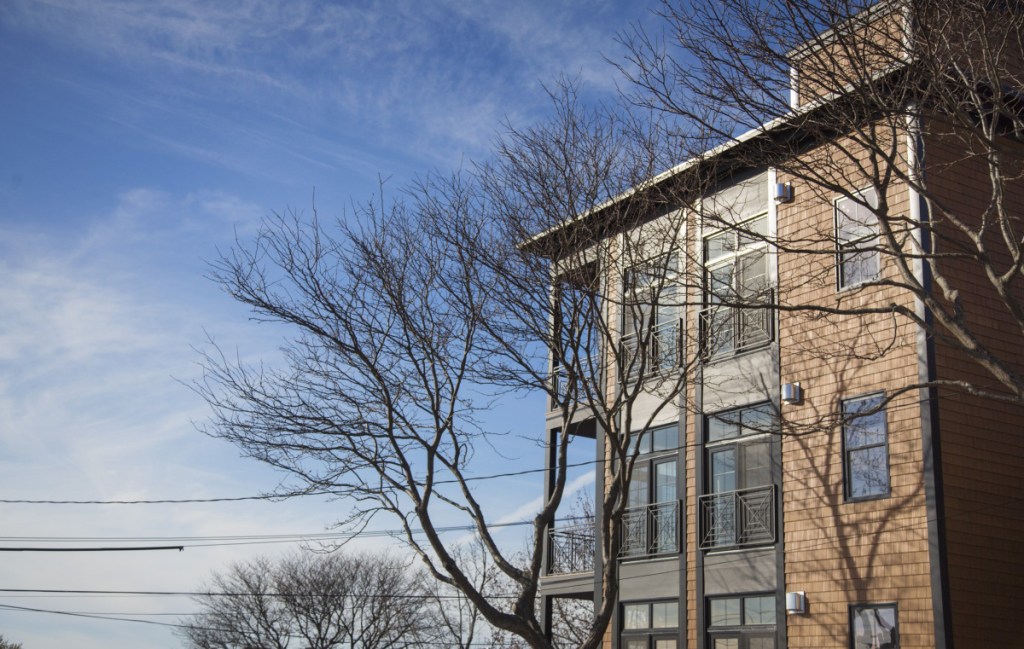Portland city councilors voted 8-1 late Monday night to approve a proposal to address development concerns on Munjoy Hill.
The debate followed two hours of public comment about the rapidly changing neighborhood, where traditional homes and apartment buildings are being torn down in favor of large luxury condominiums.
After City Councilor Kimberly Cook offered several unsuccessful amendments to weaken the proposal, Mayor Ethan Strimling stepped down from the rostrum shortly before 11:30 p.m. to allow City Councilor Belinda Ray, who represents the East End and has led the initiative, to deliver the closing remarks and ask for the roll call vote.
Ray said the proposal promotes “density without claustrophobia.”
“We need that light. We need that green space. We need that interaction with the community,” Ray said.
The Munjoy Hill Conservation Overlay District would make it more difficult to demolish some architecturally significant buildings. It also would add requirements to better ensure that new buildings are built in a similar style, size and scale with those that already exist.
However, the proposal passed by the City Council stopped short of creating historic districts, which would establish more stringent restrictions on what homeowners can do with their properties. Planners will continue to explore this possibility over the summer and fall.
Councilors held a 90-minute workshop on the proposal before their business meeting and vote.
Jeff Levine, the city’s planning and urban development director, said during the workshop that special attention was being paid to Munjoy Hill because of the flurry of demolition and development activity within the tightly developed and highly coveted peninsula neighborhood with ocean views.
“Buildings are being priced now to be demolished on Munjoy Hill,” Levine said.
The rules would have originally allowed staff to impose an 18-month delay on demolition requests for buildings that meet three criteria for being “preferably preserved.” That’s defined as being built before 1930, representative of a dominant architectural style of the area and in good condition.
Cook did win council support to reduce that period to 12 months.
Levine said the goal would be to come up with a way to reuse and renovate such buildings, and if that’s not possible, to work with the owner on a new design. Once a mutually agreeable solution is crafted, planners could lift the delay, he said.
The council was under pressure to pass some version of the proposal Monday night, because its six-month moratorium on demolitions and interim planning rules was set to expire Tuesday.
Over three dozen people spoke during a two-hour public hearing, many of whom supported the conservation district and demolition delay, while also urging the council to move forward with creating specific historic districts on the hill.
“Long-term residents of the hill are deeply concerned about the direction this community has gone,” Munjoy Street resident Michael Cavanaugh said. “We really think the council has the opportunity to step up here.”
Residents and policymakers are reacting to development patterns that emerged after the City Council made changes to the R-6 zone. Those changes opened up smaller lots for development.
Since then, large boxy condominiums have popped up next to more traditional-style homes and apartments. In some cases they are built to the property lines, reducing the amount of sun and light between buildings and making the streets less welcoming, residents said.
“Those Soviet structures are popping up like Japanese knotweed,” Morning Street resident John Wuesthoff said.
However, some building professionals and property owners urged caution.
Developer Greg Shinberg said the city should rethink it’s opposition to allow parking garage entrances on the front of buildings, because many homes are built on steep slopes. Each proposal should be judged on its own merits, he said.
“Every site is different,” Shinberg said. “You’re going to make it more difficult to integrate smart parking solutions.”
Kevin Carter said he bought a vacant building after getting an informal buy-in from city planners about his redevelopment proposal. Then the council enacted a moratorium and would not let him pull permits. Now he’s been incurring expenses without knowing what he’ll be able to do.
“It’s not fair that you are pulling the rug out from under us,” Carter said.
After more than three dozen people spoke about plans to create a Munjoy Hill Conservation Overlay District, councilors took up a series of proposed amendments to the proposal recommended by the Planning Board.
The proposal would reduce the maximum building height from 45 feet to 35 feet, unless the building includes three or more units or a workforce housing unit. Ray’s amendment to require one of those three units to be affordable to a middle income family was supported by an 8-1 vote.
Shortly before 10 p.m., Cook, who opposed Ray’s proposal, began presenting her amendments, which were supported by developers. Cook unsuccessfully sought to reduce proposed setbacks, which would still be larger than current rules allow, and to sunset the demolition delay in one year.
Randy Billings can be contacted at 791-6346 or at:
rbillings@pressherald.com
Twitter: randybillings
Send questions/comments to the editors.



